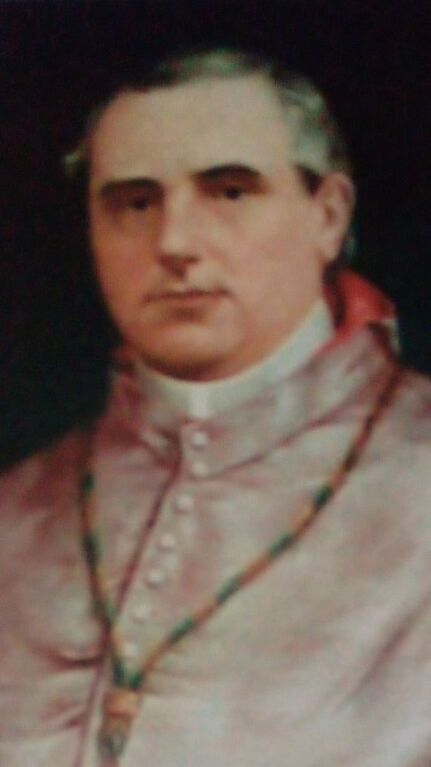|
By Barry Lally When Ballinasloe Urban District Council decided to rebrand Victoria Street in the 1940s they opted for Duggan Avenue, a name recalling a 19th-century Bishop of Clonfert noted for his support of the Land League, and who had been chosen as the first patron of the GAA, and honour he was obliged to forgo because of ill-health in favour of Archbishop Croke. However, a local sportsfield already bore Duggan’s name, and his association with the town was at best peripheral. His immediate predecessor, it could be argued, had a superior claim to be commemorated since he had spent his boyhood just around the corner in Dunlo Street and was the only Ballinasloe man ever to become a Roman Catholic bishop.
Reportedly a relative of Patrick Fallon, bishop of Kilmacduagh and Kilfenora from 1852 to 1866, John Derry was born in the parish of Moore on19th June 1811 and brought up in his father’s public house opposite Bruton’s yard, which towards the end of the century became the site of the Presbytery. At the time, varying in quality, there were seven private schools in Ballinasloe. Young Derry attended the academy run by John O’Farrell, regarded as being at the top of the scale and charging fees of seven shillings per quarter. The school catered for both Catholic and Protestant pupils. Its curriculum included reading, writing, arithmetic, geography, Latin and Greek. Bishop Thomas Coen, coadjutor to Bishop Costello, sent Derry at a comparatively early age to study for the priesthood at Maynooth, where he distinguished himself in philosophy, science, theology and scriptural studies. Ordained in 1834, he served for three years as second junior dean, a position he was obliged to relinquish as a result of his intemperate response to a student’s complaint about the quality of meat served at table in the college refectory. Subsequently he was appointed parish priest of the united parishes of Ballymacward and Gurteen, and while there he became embroiled in the decades-long Clancarty estate schools controversy, about which I wrote at some length in a previous article. In 1844 he advised his parishioners to withdraw their children from the Earl’s school. His action prompted a riposte by Lord Clancarty in the form of a letter to the local schoolmaster: “I do not wish my tenants to be swayed by any other motive than their sense of duty to their children, and of the value of the education offered to them, in the course they may adopt in respect of the school. If, however, they prefer acting as advised or rather commanded by Mr. Derry to shake off all obligation to their landlord by paying him their lawful contract, I shall certainly regret the motive with which the advice is given and accepted, although in a pecuniary way I shall be the gainer, as I believe many to whom this advice was addressed have the accommodation of holding in hand the hanging gale of rent.” Following Bishop Coen’s death on 27th April 1847 the diocesan clergy submitted the name of Dr. Robert ffrench Whitehead, a native of Creagh and vice-president of Maynooth College, as their preferred candidate to succeed Coen. Rome’s choice, however, was John Derry, who was consecrated as Bishop of Clonfert on 21st September 1847. In 19th-century Ireland the influence of a Catholic prelate could prove so decisive in determining the outcome of an electoral contest that political aspirants often found it expedient to court the favour of the local bishop. Thus, when William Gregory of Coole, future husband of Lady Augusta Gregory of Abbey Theatre fame, planned a return to Parliament in 1852 he sought Derry’s endorsement. He received a chilling rebuff. “It would require indeed a very thorough renunciation of hereditary prejudices and a total renunciation of influential family ties to qualify Mr. Gregory as a candidate for the Catholic party,” remarked the Bishop, who went on to point out that not only was Gregory connected to the proselytizing Clancarty family but he was identified as the author of the infamous clause in the Poor Relief Act whereby the occupier of a quarter acre of land was required to surrender his holding to qualify his family for outdoor relief. Derry then went on to specify terms for Catholic electoral support which he must have known that Gregory could not meet. By the time Gregory returned to face the electorate five years later he had at last won the respect of the Bishop who had found him both helpful in securing copies of proposed legislation and responsive in his concern for the spiritual welfare of Catholics. A peculiar grievance was the practice of raising children in the workhouse as members of the Church of Ireland whenever the religion of their parents had not been conclusively established. So, in March 1859, Gregory had introduced a bill to amend the Poor Relief (Ireland) Act seeking to restrict the discretionary power of the Poor Law Guardians to those cases where there was no clue to the parents’ religion. A child found with a rosary around its neck, for example, would be registered and educated as a Catholic. Derry expressed himself as thoroughly convinced of Gregory’s desire to act with the utmost fairness and handsomely acknowledged that he had misjudged him during the previous election. Moreover, he made known his wish to see him re-elected as a representative of County Galway. Bishop Derry is probably best remembered for his church-building programme that included Ballinasloe’s St. Michael’s, an outstanding example of neo-Gothic architecture. He was instrumental in persuading Cardinal Wiseman, head of the English hierarchy, to preside at its consecration in 1858. Two years earlier Ballinasloe had become a mensal parish and the Chapter of Canons was abolished. Initially invited by the Bishop to establish themselves in Loughrea, the Mercy nuns set up a second convent in Ballinasloe in 1853. When they first came to town they occupied a building in Main Street opposite the Earl of Clancarty’s townhouse (now the Bank of Ireland). Over the following century the Sisters made a significant contribution to both primary and secondary education in the locality. Though suffering from a serious heart ailment, Bishop Derry travelled to Rome to attend the First Vatican Council in November 1869. On his return he stopped over in Dublin to be treated by Sir Dominic Corrigan, an eminent cardiologist. His condition unfortunately did not improve and he died at his sister’s residence in Brideswell on 2nd July 1870.
0 Comments
Leave a Reply. |
CLICK HERE to read the Latest Ballinasloe News Articles
June 2024
|
The Town Team was set up by BACD Ltd. to revive the fortunes of Ballinasloe and its hinterland. With the main focus to build on the town’s many strengths, change existing negative perceptions and bring about measurable improvements in the town centre economy and its wider social value.
|
Ballinasloe Area Community Development Ltd.
Ballinasloe Enterprise Centre Creagh Ballinasloe Co. Galway |
All generic photos and images have been sourced and are free of copyright or are clip art images free of copyright. Photos of Ballinasloe have been donated by BEC. If you have any photos that you would like included on the website please email us
Copyright © All rights reserved, 2024 BACD


 RSS Feed
RSS Feed
